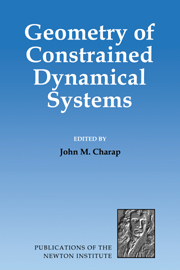Book contents
- Frontmatter
- Contents
- The network
- Preface
- The constraint algebra of higher dimensional Chern-Simons theories
- Nonrelativistic Chern-Simons vortices from the constrained Hamiltonian formalism
- Classical solutions of gravitating Chern-Simons electrodynamics
- Exponentially localised instantons in a hierarchy of Higgs models
- Obstructions to ganging WZ terms: a symplectic curiosity
- Global aspects of symmetries in sigma models with torsion
- Canonical structure of the non-linear σ-model in a polynomial formulation
- A manifestly gauge-invariant approach to quantum theories of gauge fields
- On the Hamiltonian formulation of higher dimensional Chern-Simons gravity
- An Example of Loop Quantization
- Gauge fixing in constrained systems
- Light-cone formulation of gauge theories
- Hamiltonian constraints and Dirac observables
- Gauging kinematical and internal symmetry groups for extended systems
- On the harmonic interaction of three relativistic point particles
- Non existence of static multi-black-hole solutions in 2+1 dimensions
- Spherically symmetric gravity and the notion of time in general relativity
- Canonical decomposition of Belinskii-Zakharov one-soliton solutions
- Hamiltonian reduction and the R-matrix of the Calogero model
- Intrinsic approach to the Legendre transformation in super-mechanics
- Field-antifield description of anomalous theories
- Transfer matrix quantization of general relativity, and the problem of time
- The W3-particle
- Pure geometrical approach to singular Lagrangians with higher derivatives
- Dirac versus reduced phase space quantization
- Classical and quantum aspects of degenerate metric fields
- BRST-antibracket cohomology in 2d conformal gravity
- Quantisation of 2 + 1 gravity for g = 1 and g = 2
- Geometry and dynamics with time-dependent constraints
- Collective coordinates and BRST transformations or Gauge theories without gauge fields
- Geometry of fermionic constraints in superstring theories
- BRST and new superstring states
- Generalized canonical quantization of gauge theories with polarized second–class constraints
- Radiation field on superspace
- Participants
Intrinsic approach to the Legendre transformation in super-mechanics
Published online by Cambridge University Press: 05 November 2011
- Frontmatter
- Contents
- The network
- Preface
- The constraint algebra of higher dimensional Chern-Simons theories
- Nonrelativistic Chern-Simons vortices from the constrained Hamiltonian formalism
- Classical solutions of gravitating Chern-Simons electrodynamics
- Exponentially localised instantons in a hierarchy of Higgs models
- Obstructions to ganging WZ terms: a symplectic curiosity
- Global aspects of symmetries in sigma models with torsion
- Canonical structure of the non-linear σ-model in a polynomial formulation
- A manifestly gauge-invariant approach to quantum theories of gauge fields
- On the Hamiltonian formulation of higher dimensional Chern-Simons gravity
- An Example of Loop Quantization
- Gauge fixing in constrained systems
- Light-cone formulation of gauge theories
- Hamiltonian constraints and Dirac observables
- Gauging kinematical and internal symmetry groups for extended systems
- On the harmonic interaction of three relativistic point particles
- Non existence of static multi-black-hole solutions in 2+1 dimensions
- Spherically symmetric gravity and the notion of time in general relativity
- Canonical decomposition of Belinskii-Zakharov one-soliton solutions
- Hamiltonian reduction and the R-matrix of the Calogero model
- Intrinsic approach to the Legendre transformation in super-mechanics
- Field-antifield description of anomalous theories
- Transfer matrix quantization of general relativity, and the problem of time
- The W3-particle
- Pure geometrical approach to singular Lagrangians with higher derivatives
- Dirac versus reduced phase space quantization
- Classical and quantum aspects of degenerate metric fields
- BRST-antibracket cohomology in 2d conformal gravity
- Quantisation of 2 + 1 gravity for g = 1 and g = 2
- Geometry and dynamics with time-dependent constraints
- Collective coordinates and BRST transformations or Gauge theories without gauge fields
- Geometry of fermionic constraints in superstring theories
- BRST and new superstring states
- Generalized canonical quantization of gauge theories with polarized second–class constraints
- Radiation field on superspace
- Participants
Summary
In recent years, there has been an increasing interest to provide supermechanics with a solid geometrical base. Some of the difficulties are right at the beginning: there is a general consent about the configuration space, which is taken to be a supermanifold, but there is no general agreement on what the velocity phase space should be. Naturally, the candidate for that should be a generalization of the tangent bundle in the context of supergeometry; unfortunately there are several different (and reasonable) notions that could serve that purpose. The tangent supermanifold introduced by Ibort and Marín-Solano in [8] seems to be the right candidate from the point of view of a physicist since a good deal of supermechanics can rigorously be developed; nevertheless, the main disadvantage of the tangent supermanifold is that it is not a bundle in any sense, which forces a local coordinate approach that does not give too much insight, or a purely algebraic approach, in practice difficult to handle; besides, in classical mechanics one usually takes advantage of the fact that vector fields, for instance, are, after all, sections of a bundle. In this sense, the tangent superbundle introduced by Sánchez–Valenzuela [10,11,2] seems to be quite appropriate, from a theoretical point of view, since there is a one–to–one correpondence between sections of this superbundle and supervector fields regarded as superderivations. Unfortunately, the tangent superbundle is too big, its dimension is (2m + n, 2n + m) if the dimension of the configuration space is (m,n).
Information
- Type
- Chapter
- Information
- Geometry of Constrained Dynamical Systems , pp. 195 - 202Publisher: Cambridge University PressPrint publication year: 1995
